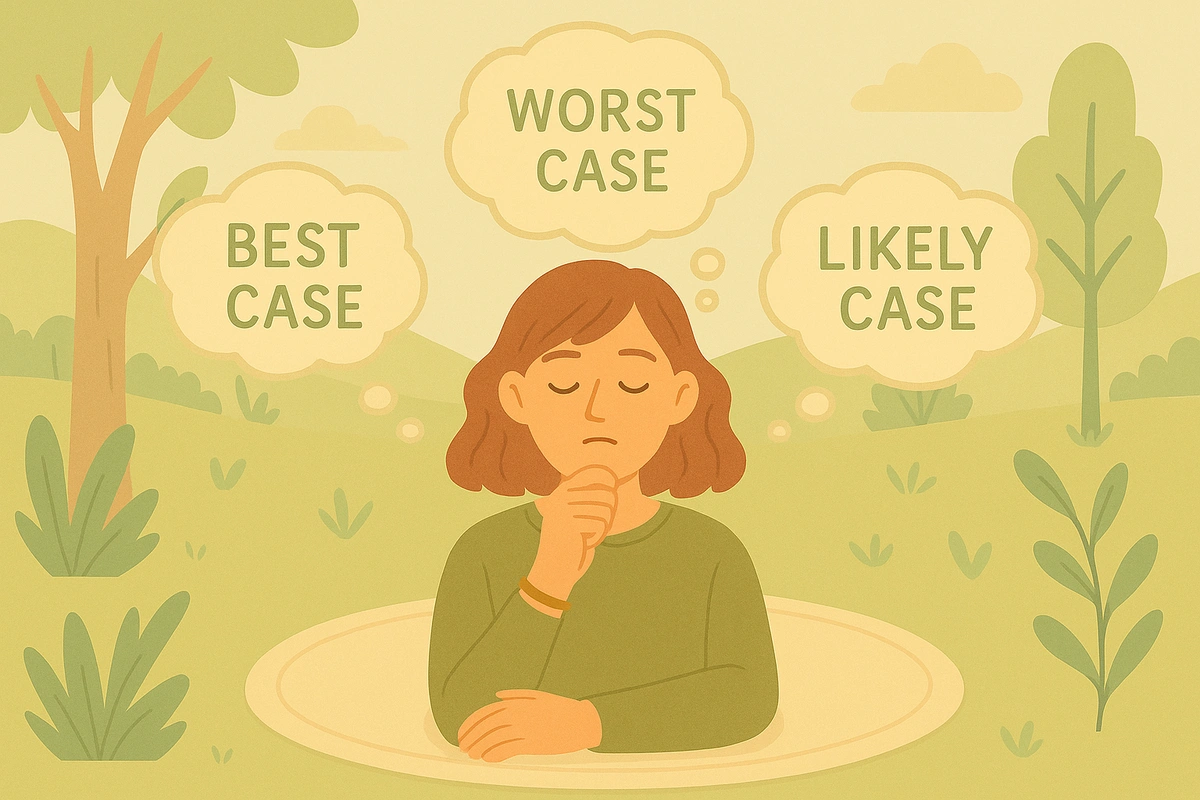The Worst, Best, and Most Likely Case technique helps you challenge catastrophic thinking by systematically evaluating three possible outcomes for any anxiety-provoking situation. This cognitive restructuring exercise restores balanced perspective by breaking the cycle of worst-case scenario thinking that fuels anxiety and overwhelm.

This practical anxiety management technique involves deliberately examining the worst, best, and most realistic possible outcomes of a stressful situation. By systematically evaluating all three scenarios, you challenge your brain's natural tendency toward catastrophic thinking and develop a more balanced, evidence-based perspective on future events.
Anxiety often hijacks rational thinking by making your brain focus exclusively on worst-case scenarios. An estimated 4% of the global population currently experience an anxiety disorder, and catastrophic thinking patterns contribute significantly to this distress. When you're caught in worry spirals, your mind operates like a broken record player stuck on the most frightening track. This technique acts like your brain's reset button, helping you step back from emotional overwhelm and engage your logical thinking centers to assess situations more accurately.
This technique combats anxiety by directly challenging your brain's built-in negativity bias - the evolutionary survival mechanism that makes you anticipate danger as a protective mechanism. While this ancient system helped our ancestors survive physical threats, it often creates unnecessary suffering in modern life by making remote possibilities feel like certain catastrophes.
Cognitive restructuring is a group of therapeutic techniques that help people notice and change negative thinking patterns by replacing distorted thoughts with more balanced perspectives. When you systematically examine worst, best, and likely scenarios, you activate your prefrontal cortex - the brain region responsible for rational analysis and executive decision-making.
Research on cognitive behavioral therapy techniques shows that questioning thoughts and assumptions helps determine where automatic thoughts are biased or illogical. The three-scenario approach works like a mental courtroom where you examine evidence for and against your catastrophic predictions, often discovering that your worst fears lack solid supporting evidence.
Research shows that cognitive restructuring techniques produce significant improvements in therapy outcomes because they help people develop what psychologists call "cognitive flexibility" - the ability to consider multiple perspectives and adapt thinking based on evidence rather than emotion.
The technique also reduces what researchers call "probability overestimation" - the tendency to dramatically overestimate the likelihood of negative events when anxious. Think of your anxious brain like a smoke detector that's overly sensitive, sounding alarms for burnt toast as if it were a house fire. This exercise recalibrates your threat detection system to distinguish between genuine concerns and anxiety-driven false alarms.
"I keep getting stuck on the worst-case scenario and can't move to other possibilities" - This is normal when anxiety is high. Start by setting a timer for just 2-3 minutes to explore the worst case, then forcibly move to the best case even if it feels artificial. Your brain needs practice switching between different perspectives.
"My best-case scenario feels unrealistic or impossible" - Remember that the goal isn't to predict the future perfectly but to expand your thinking beyond catastrophic focus. Even unlikely positive outcomes help balance your perspective and reduce the emotional weight of worst-case fears.
"The most likely scenario still feels negative" - This might indicate that you're dealing with a genuinely challenging situation rather than anxiety-distorted thinking. Focus on developing realistic coping strategies and remember that being prepared for difficulties is different from catastrophizing about them.
"I feel silly writing down obvious outcomes" - The power lies in the process, not the content. Seeing thoughts on paper removes their emotional charge and engages your rational thinking centers. What feels obvious when calm becomes profound when you're in an anxiety spiral.
"This technique makes me more anxious because I'm thinking about bad outcomes" - Initially, some people find that deliberately examining fears increases anxiety temporarily. This discomfort typically decreases with practice as you gain evidence that most worst-case scenarios don't occur. Consider starting with very minor concerns to build tolerance gradually.
"I can't stop analyzing every possible detail of each scenario" - Set time limits for each section (5 minutes for worst case, 5 for best case, 5 for most likely) to prevent overthinking. The goal is balanced perspective, not exhaustive analysis of every possibility.